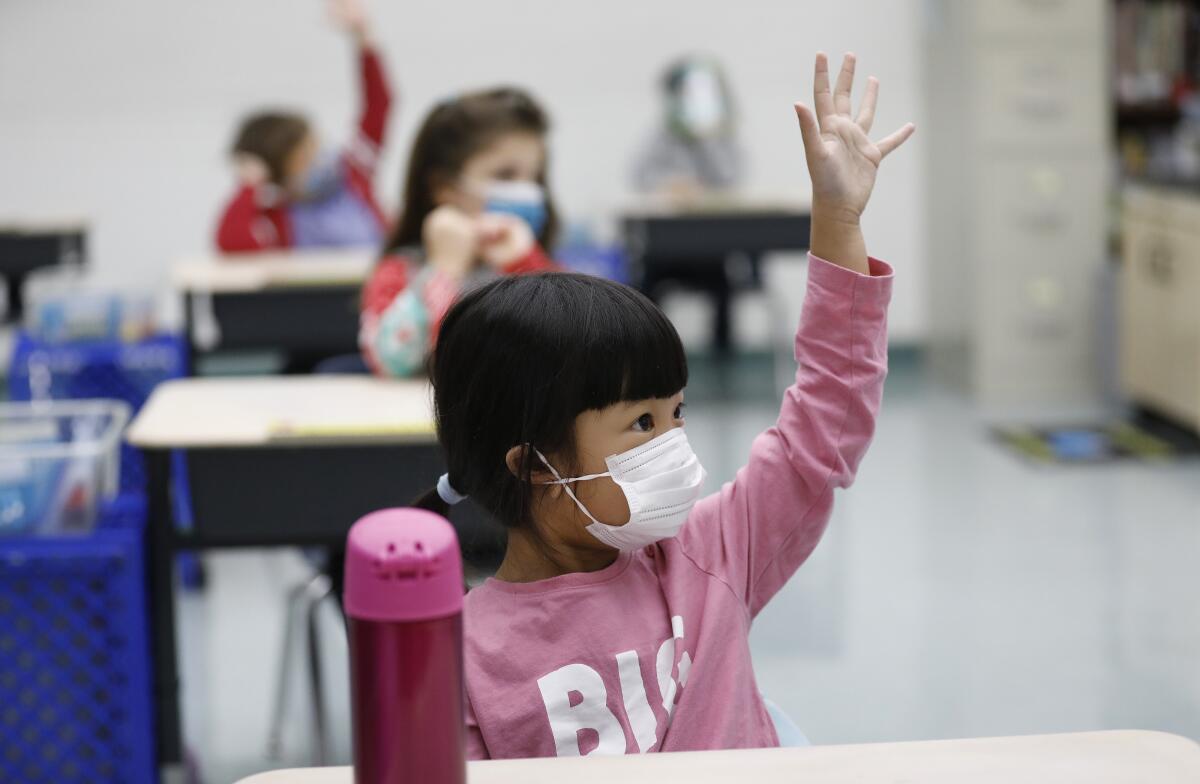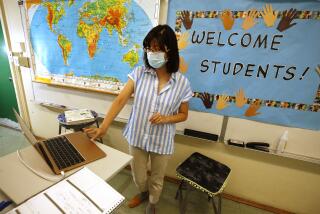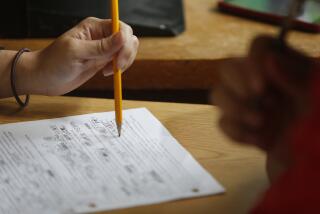Op-Ed: Pandemic learning loss is real. Schools must follow the science to make up for it

When the stakes are high for policy decisions, as they of course are during a public health crisis, we hear the mantra “follow the science.” As millions of students are back in class for the third school year affected by COVID-19, this tenet applies to schools as well.
Parents and teachers alike are concerned about the loss of learning caused by the COVID-19 pandemic. One prominent study found that the average student had fallen five months behind in math and four months in reading by the end of the school year. But those numbers also hide inequalities; for low-income schools, the number for math is seven months.
Parents and schools understandably want to catch up immediately, but it’s unrealistic to think that a few months of anything will fully close the gaps the pandemic has created. More likely, educators are looking at a long game, perhaps three or more years during which schools must do their core work better. If we simply return to pre-pandemic methods, that won’t happen — because before the pandemic, we weren’t really following the science.
For instance, a science-based pedagogy will require a shift to include much greater emphasis on the knowledge of facts. Educators tend to underestimate the importance of knowledge, as though teaching rote facts detracts from teaching higher-order thinking. But the science shows otherwise. “The very processes that teachers care about most,” like critical thinking and problem solving, “are intimately intertwined with factual knowledge that is stored in long-term memory,” writes Daniel Willingham, a cognitive scientist at the University of Virginia.
What we perceive to be critical thinking is often our brains connecting bits of knowledge. Yet we continue to romanticize an impossible shortcut: teaching critical thinking as if it were a universally applicable skill.
Nowhere is this more obvious and more problematic than the subject of reading, which schools see as a set of transferable thinking skills that can be taught directly: I will teach students what an inference is, and this will allow them to make inferences about whatever text they read. In reality, students make inferences when they can read fluently — at the speed of sight — and have the vocabulary and background knowledge to name what the author leaves unsaid.
Educators also often underestimate memory. The knowledge gained from learning facts must be stored well and easily accessed to be of use. Cognitive scientist Paul Kirschner argues that building memory is “the aim of all instruction” and that “if nothing has changed in long-term memory, nothing has been learned.”
It’s uncomfortable to think that so much of what we do in school boils down to something so mundane, but Kirschner shows that memory is the difference between performance and learning.
Performance is a temporary change in actions or thoughts achieved while engaging in study. At the end of a lesson, if students appear to understand an idea, their teacher may think, “Great, they really understand juxtaposition.” But if weeks later, perhaps at the time of the test, the students don’t remember anything about juxtaposition, learning has not really occurred.
A good classroom reliably transforms performance into learning by requiring students to recall and put into practice things they have learned after a delay. This is known as retrieval practice. Without it, students begin learning only to have their grasp slip away.
Educators also resist the evidence that experts learn differently from novices. For novices (like most students in the beginning stages of most pursuits), dynamic, engaging forms of direct instruction are most efficient, especially woven together with careful examples, questions and retrieval practice. Conversely, experts do better with projects and real-world problems. Novices in such cases attend to far more noise than signal and, ultimately, learn less. Cognitive scientist John Sweller calls this phenomenon the “guidance fading effect.” The bottom line: Start with direct instruction enlivened by short breaks for questioning and reflection.
In a time of crisis, like after two years of pandemic learning loss, we are apt to spend immense resources inefficiently unless we acknowledge that facts and memory are worthy goals and that direct instruction has a role to play.
Finally, we must consider students’ emotional needs, now more than ever because so many have been isolated.
Belonging is one of the most profound human emotions and motivators. It’s necessary for psychological safety, and the work of building it is never complete. Consider a classroom in which students are socialized to begin their comments by referring to what a previous student said: “I agree with Cassidy and want to provide another example.” That conveys to Cassidy that her comments were meaningful to her peers. This would also be achieved if, when Cassidy is speaking, her classmates are looking at her, nodding and sending positive nonverbal social signals that they value her words. Only peers can provide this sense of belonging, but teachers can foster the environment as a social norm.
Our perception of social norms is the most important influence on what we do and think. A classroom where students see others engage positively and consistently in learning is one where they are far more likely to do so themselves.
Educators can set up their classrooms for productive social norms with clear procedures and routines. For example, a teacher might say, “Take one minute to discuss your reaction to the passage with your partner.” By default, then everyone is engaged. Or they are if students expect their peers to engage. Then they will too, and the room will crackle to life. Without clear, well-established norms, students are likely to play a game of wait-and-see and lose out on the discussion.
If we want to make post-pandemic schools better for students, we must ground our teaching in the science that reveals the importance of knowledge and memory, the need to meet students where they are, and the outsize role that belonging plays in students’ educational lives. Approaches rooted in those fundamentals will bear fruit long after students catch up from pandemic learning loss. Students have lost out on too much already. Let’s make every moment count.
Doug Lemov, author of “Teach Like a Champion 3.0,” is a managing director at Uncommon Schools.
More to Read
A cure for the common opinion
Get thought-provoking perspectives with our weekly newsletter.
You may occasionally receive promotional content from the Los Angeles Times.










